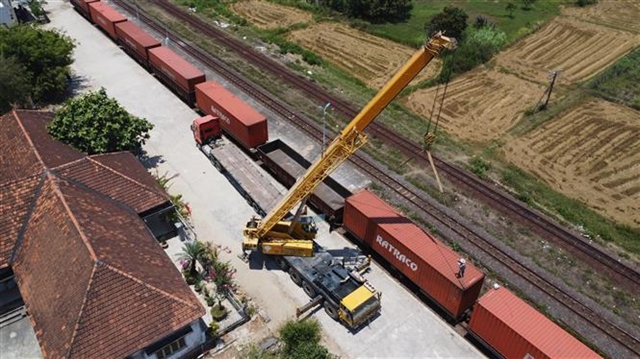
|
| Freight train carriages are stuck following a landslide at the Bãi Gió Tunnel through Đèo Cả connecting Khánh Hòa and Phú Yên provinces, causing a major blockage on the North-South railway line. VNA/VNS Photo |
HÀ NỘI — Việt Nam Railway Corporation (VNR) has recommended prioritising the allocation of approximately VNĐ1.29 trillion (US$50.7 million) for the urgent reinforcement of railway works facing high safety risks.
This includes about VNĐ500 billion ($19.6 million) for reinforcing 12 critical tunnels, VNĐ700 billion ($27.5 million) for reinforcing 94 bridges and VNĐ95 billion ($3.7 million) for reinforcing 14 additional works. These crucial projects will be part of the mid-term public investment capital plan for the period of 2026-2030, or will supplement annual maintenance and repair funding.
A representative from the Việt Nam Railway Authority also stated that investment should focus on the Hà Nội – HCM City railway line, which has the highest passenger traffic.
For the Hà Nội – Đồng Đăng, Yên Viên – Lào Cai and Gia Lâm – Hải Phòng lines, targeted investments should ensure safety and prioritise stations with high transportation demand.
Regarding funding sources, the authority has proposed to the Ministry of Transport that smaller projects with less complex technical requirements should use annual railway infrastructure maintenance funds. Larger, more technically complex projects should be allocated mid-term public investment capital for the 2026-2031 period.
Approximately VNĐ5 billion would be allocated from economic operational funds to inspect 12 tunnels on the Hà Nội – HCM City railway line, and about VĐ3 billion to inspect Hà Nội, Hải Phòng and Đà Lạt stations. Additionally, a project to reinforce the weak tunnels on the Hà Nội – HCM City railway line aimed to provide temporary safety measures for critical sections with high safety risks until a comprehensive renovation project can be carried out, it said.
While waiting for the projects to be implemented, the VNR would direct railway joint-stock companies to inspect, monitor and be on standby with sufficient materials, personnel and equipment to respond promptly to any emergency situations.
Many railway tunnels and bridges are facing safety risks due to their age, raising serious concerns about train safety. In April 2024, the Bãi Gió Tunnel on the north-south railway line through Đèo Cả experienced a landslide during construction, causing a nearly ten day blockage of the national railway. Similarly, the Chí Thạnh Tunnel also suffered a landslide at the end of May. Fortunately, there were no casualties from either landslide.
The VNR reported that the Bãi Gió Tunnel landslide alone cost the corporation over VNĐ50.4 billion. This included more than VNĐ3.6 billion in emergency response costs, over VNĐ18.7 billion in direct damages and over VNĐ28 billion in lost revenue due to the disruption.
Additionally, the prolonged impact of the incident led many passengers and shippers to switch to alternative modes of transport, resulting in a revenue decline even after the issue was resolved.
According to the VNR, the entire network has 12 tunnels which are considered in a critical condition, out of a total of 39. These 12 tunnels are all on the Hà Nội – HCM City line, built and put into operation between 1926 and 1936 and have never been repaired, reinforced or renovated.
The concrete linings of these tunnels have deteriorated, cracked and become waterlogged, with narrow clearances posing significant safety risks, requiring reduced train speeds.
According to Nguyễn Văn Định, head of the Đèo Cả railway management team, the area has seven tunnels, all built during the French colonial period and now heavily weathered and leaking.
The Đèo Cả area, the soil and rocks are loose, making landslides more likely during the rainy season.
A recent project with a budget of VNĐ7 trillion (275.6 million) only reinforced three tunnels, mainly addressing water leakage points. The iron sleepers used in these tunnels, dating back to the French era, are heavily corroded and replacements are scarce since they are no longer manufactured. The unit had to select usable iron sleepers from other projects to replace concrete ones as a precaution. — VNS
- Reduce Hair Loss with PURA D’OR Gold Label Shampoo
- Castor Oil Has Made a “Huge” Difference With Hair and Brow Growth
- Excessive hair loss in men: Signs of illness that cannot be subjective
- Dịch Vụ SEO Website ở Los Angeles, CA: đưa trang web doanh nghiệp bạn lên top Google
- Nails Salon Sierra Madre
 VnExpress News The News Gateway of Vietnam
VnExpress News The News Gateway of Vietnam





